roof Citroen DS5 HYBRID4 2013 1.G Owner's Manual
[x] Cancel search | Manufacturer: CITROEN, Model Year: 2013, Model line: DS5 HYBRID4, Model: Citroen DS5 HYBRID4 2013 1.GPages: 364, PDF Size: 10.21 MB
Page 5 of 364
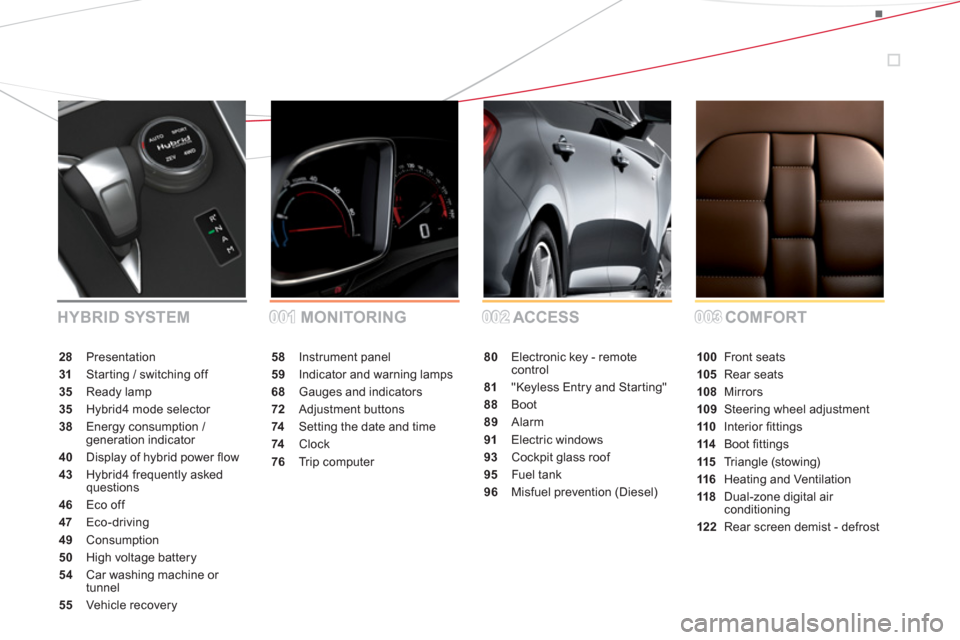
58 Instrument panel
59 Indicator and warning lamps
68Gauges and indicators
72 Adjustment buttons
74 Setting the date and time
74 Clock
76Tr i p c o m p u ter
80Electronic key - remote control
81 "Keyless Entry and Starting"
88Boot
89 Alarm
91Electric windows
93 Cockpit glass roof
95Fuel tank
96 Misfuel prevention (Diesel)
100 Front seats
105 Rear seats
108Mirrors
109Steering wheel adjustment
110Interior fi ttings
114 Boot fi ttings
115Tr i a ngle (stowing)
116 Heating and Ventilation
118Dual-zone digital air conditioning
122Rear screen demist - defrost
28 Presentation
31 Starting / switching off
35 Ready lamp
35 Hybrid4 mode selector
38 Energy consumption / generation indicator
40Display of hybrid power fl ow
43 Hybrid4 frequently askedquestions
46 Eco off
47Eco-driving
49Consumption
50 High voltage battery
54 Car washing machine or
tunnel
55Vehicle recovery
001001002002003003COMFORT ACCESS MONITORING HYBRID SYSTEM
Page 7 of 364
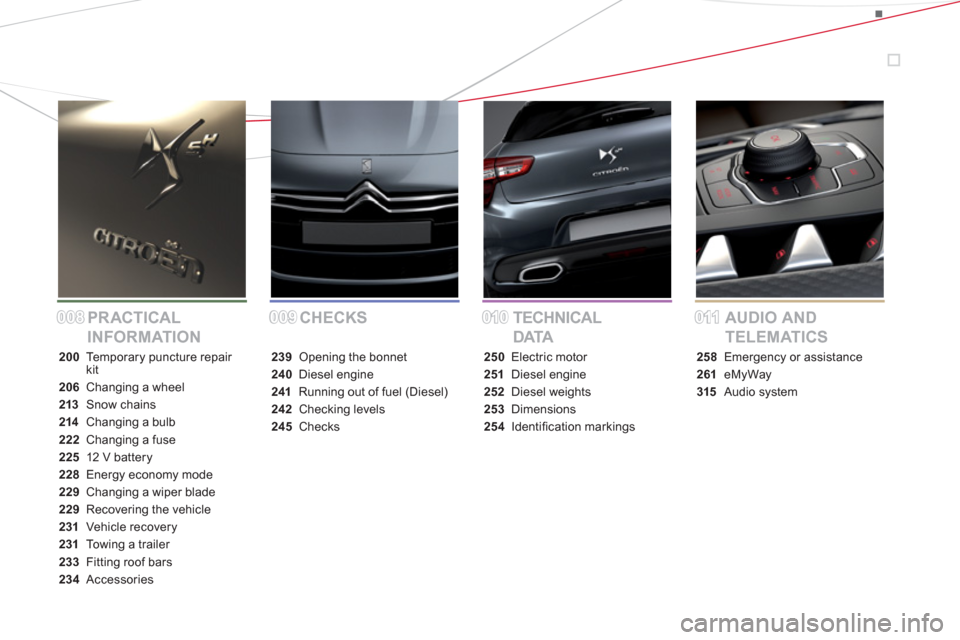
CHECKS PR ACTICAL
INFORMATIONTECHNICAL
DATAAUDIO AND
TELEMATICS
200 Te m p o r a ry puncture repair
kit
206 Changing a wheel
213Snow chains
214Changing a bulb
222Changing a fuse
225 12 V battery
228Energy economy mode
229Changing a wiper blade
229Recovering the vehicle
231Vehic le recovery
231To w i ng a trailer
233 Fitting roof bars
234Accessories
239Opening the bonnet
240 Diesel engine
241 Running out of fuel (Diesel)
242Checking levels
245 Checks
250 Electric motor
251 Diesel engine
252Diesel weights
253 Dimensions
254 Identifi cation markings
258Emergency or assistance
261eMyWay
315 Audio system
008008009009010010011011
Page 11 of 364
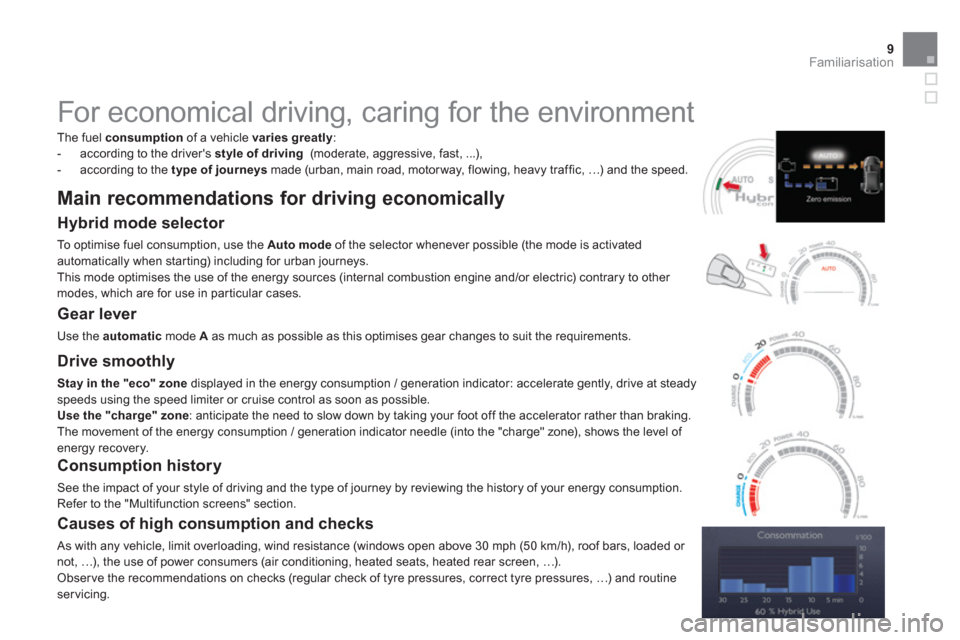
9Familiarisation
For economical driving, caring for the environment
The fuel consumptionof a vehicle varies greatly:
- according to the driver's style of driving
(moderate, aggressive, fast, ...),
- accordin
g to the type of journeys
made (urban, main road, motor way, flowing, heavy traffic, …) and the speed.
Main recommendations for driving economically
Hybrid mode selector
To optimise fuel consumption, use the Automodeof the selector whenever possible (the mode is activated
automatically when starting) including for urban journeys.
This mode optimises the use of the energy sources (internal combustion engine and/or electric) contrary to other modes, which are for use in par ticular cases.
Gear lever
Use the automatic
mode A
as much as possible as this optimises gear changes to suit the requirements.
Causes of high consumption and checks
As with any vehicle, limit overloading, wind resistance (windows open above 30 mph (50 km/h), roof bars, loaded or not, …), the use of power consumers (air conditioning, heated seats, heated rear screen, …).
Obser ve the recommendations on checks (regular check of tyre pressures, correct tyre pressures, …) and routine servicing.
Drive smoothly
Stay in the "eco" zone
displayed in the energy consumption / generation indicator: accelerate gently, drive at steadyspeeds using the speed limiter or cruise control as soon as possible.Use the "charge" zone: anticipate the need to slow down by taking your foot off the accelerator rather than braking.
The movement of the energy consumption / generation indicator needle (into the "charge" zone), shows the level of energy recovery.
Consumption history
See the impact of your style of driving and the type of journey by reviewing the history of your energy consumption.Refer to the "Multifunction screens" section.
Page 18 of 364

14 . Controls for electric windows / electric child lock / central locking.
15. eMyWay controls.
16.Gear selector.
17. Hybrid4 mode selector.
18
. Heating / air conditioning controls.
19.Audio system.
20.Hazard warning lamps. 21. Multifunction screen.22.Central adjustable air vents.
23.Clock.
24.Starting with the STA R T/STOP button.
25. Electronic key reader.
26. Wiper / screenwash / trip computer stalk.
Instruments and controls
1.
Bonnet release lever.2.
Headlamp height adjustment. 3.
Side adjustable air vents.4.
Front door window demisting/defrosting
vents.
5. Quarter light demisting windows.
6.Head-up display.7. Windscreen demisting/defrosting vent.8.Passenger's airbag. 9.
Glove box / Passenger's airbag deactivation inside. 10.12 V accessory socket. 11.
Rear electric window controls.12.Central armrest with storage.
USB por t / auxiliary socket. 13.Electric parking brake.
27. Audio equipment steering mountedcontrols. 28.
Driver's airbag.
Horn. 29. Cruise control / speed limiter controls.
30.
Switch panel (see previous page).31.Door mirror adjustment.32.
Lighting and direction indicator stalk33.
Instrument panel. 34.Seat belt and airbag warning lamps. 35.Cour tesy lamp. 36.Head-up display controls. 37.
Controls for cockpit glass roof blind. 38.CITROËN Localised Emergency Call - CITROËN Localised Assistance Call.
Page 49 of 364

47Hybrid system
Eco-driving
Eco-driving is a range of everyday practices that allow the motorist to optimise their fuel consumption and CO2 emissions.
Eco-driving suited to your
Hybrid4 vehicle
Use gear selector position A , as thisoptimises gear changes to suit the circumstances, and the AUTOmode of theHybrid4 mode selector.When moving off, accelerate normally up tothe desired speed ( POWER
zone between20 and 40 %). At steady speeds, drive gently with smallmovements of the accelerator pedal (ECOor CHARGEzone), run in electric mode as oftenas possible when driving at low speed. Anticipate the need to slow down and useengine braking ( CHARGE
zone), so as to make use of free energy recovery while keeping light pressure on the accelerator pedal.
Before moving off, if the passenger compartment is too warm, ventilate it byopening the windows and air vents beforeusing the air conditioning.
Above 30 mph (50 km/h), close the windowsand leave the air vents open. Remember to make use of equipment that can help keep the temperature in the passenger compar tment down (sun roof andwindow blinds...).Switch off the air conditioning, unless it has automatic digital regulation, as soon as the desired temperature is attained.Switch off the demisting and defrostingcontrols, if not automatic.Switch off the heated seat as soon as possible.
Switch off the headlamps and front foglampswhen the level of light does not require their use.
Avoid running the Diesel engine when stationary, par ticularly in winter; your vehiclewill warm up much faster while driving.
As a passenger, if you avoid connecting your multimedia devices (film, music, video game...), you will contribute towards limitingthe consumption of electrical energy, and soof fuel.
Disconnect your por table devices beforeleaving the vehicle.
Control the use of your electrical equipment
Page 50 of 364
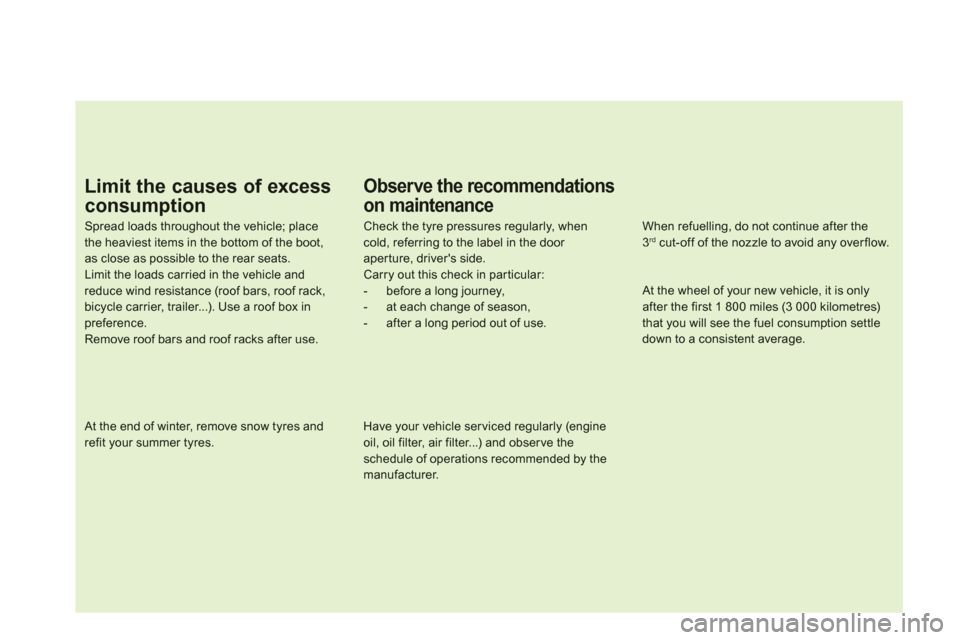
Observe the recommendations
on maintenance
Check the tyre pressures regularly, whencold, referring to the label in the door aperture, driver's side.
Carry out this check in par ticular:
- before a long journey,
- at each change of season,
- after a long period out of use.
Have your vehicle ser viced regularly (engine oil, oil filter, air filter...) and obser ve the schedule of operations recommended by themanufacturer.
When refuelling, do not continue after the3 rd
cut-off of the nozzle to avoid any over flow.
At the wheel of your new vehicle, it is onlyafter the first 1 800 miles (3 000 kilometres) that you will see the fuel consumption settle down to a consistent average.
At the end of winter, remove snow tyres and refit your summer tyres.
Spread loads throughout the vehicle; placethe heaviest items in the bottom of the boot,as close as possible to the rear seats.Limit the loads carried in the vehicle andreduce wind resistance (roof bars, roof rack,bicycle carrier, trailer...). Use a roof box in preference.Remove roof bars and roof racks after use.
Limit the causes of excess
consumption
Page 95 of 364

93Access
Cockpit glass roof
A tinted glass panoramic sur face to increase
the light and visibility in the passenger compartment.
Fitted with three electric blinds to improve
tem
perature and noise related comfort. There are two options for openin
g and closing:
Electric blinds
�) Pull or press control, going beyond the point of resistance.
One press opens or closes the blind
completely.
After a new action on the the control, the
blind continues moving for around 2 cm,
then stops.
�) Pull or press the control without goingbeyond the point of resistance (forwards to close and rear wards to open). When you release the control, the blindcontinues moving for around 2 cm, then stops.
Page 170 of 364
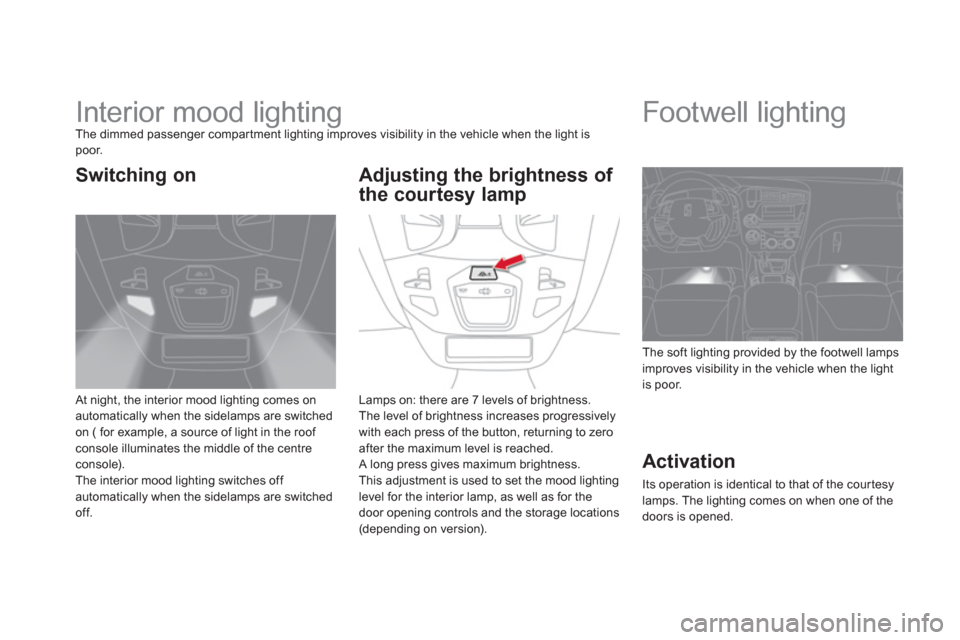
Interior mood lighting The dimmed passenger compar tment lighting improves visibility in the vehicle when the light is poor.
At night, the interior mood lighting comes onautomatically when the sidelamps are switched
on ( for example, a source of light in the roof console illuminates the middle of the centre console).
The interior mood lighting switches off automatically when the sidelamps are switched off. Lamps on: there are 7 levels o
f brightness.
The level of brightness increases progressively
with each press of the button, returning to zero after the maximum level is reached.
A long press gives maximum brightness.
This adjustment is used to set the mood lighting level for the interior lamp, as well as for the
door opening controls and the storage locations(depending on version).
Foot well lighting
Activation
Its operation is identical to that of the cour tesy
lamps. The lighting comes on when one of the
doors is opened. The so
ft lighting provided by the footwell lamps
improves visibility in the vehicle when the light
is poor.
Switching on
Adjusting the brightness of
the courtes
y lamp
Page 198 of 364

Sit in a normal upright position.
Wear a correctly adjusted seat belt.
Do not leave anything between theoccupants and the airbags (a child, pet,
object...). This could hamper the operation of the airbags or injure the occupants. After an accident or if the vehicle has beenstolen or broken into, have the airbagsystems checked. All work on the airbag system must be carried out by a CITROËN dealer or a qualified workshop.
Even if all of the precautions mentioned are obser ved, a risk of injury or of minor burns to the head, chest or arms when an airbag is deployed cannot be ruled out. Thebag inflates almost instantly (within a few milliseconds) then deflates within the sametime discharging the hot gas via openings provided for this purpose.
Lateral airbags
Use only approved covers on the seats, compatible with the deployment the lateral airbags. For information on the range of seatcovers suitable for your vehicle, you can contact a CITROËN dealer. Refer to the "Accessories" section.Do not fix or attach anything to the seat backs (clothing...). This could cause injuryto the chest or arms if the lateral airbag isdeployed.Do not sit with the upper par t of the body anynearer to the door than necessary.
Front airbags
Do not drive holding the steering wheel by its spokes or resting your hands on the centre part of the wheel.
Passengers must not place their feet on thedashboard.
If possible, do not smoke as deployment of the airbags can cause burns or the risk of injury from a cigarette or pipe.
Never remove or pierce the steering wheel or hit it violently.
For the airbags to be fully effective, observe the following safety rules:
Curtain airbags
Do not fix or attach anything to the roof. Thiscould cause injury to the head if the cur tainairbag is deployed.
If fitted on your vehicle, do not remove the grab handles installed on the roof, they playa par t in securing the cur tain airbags.
Page 235 of 364
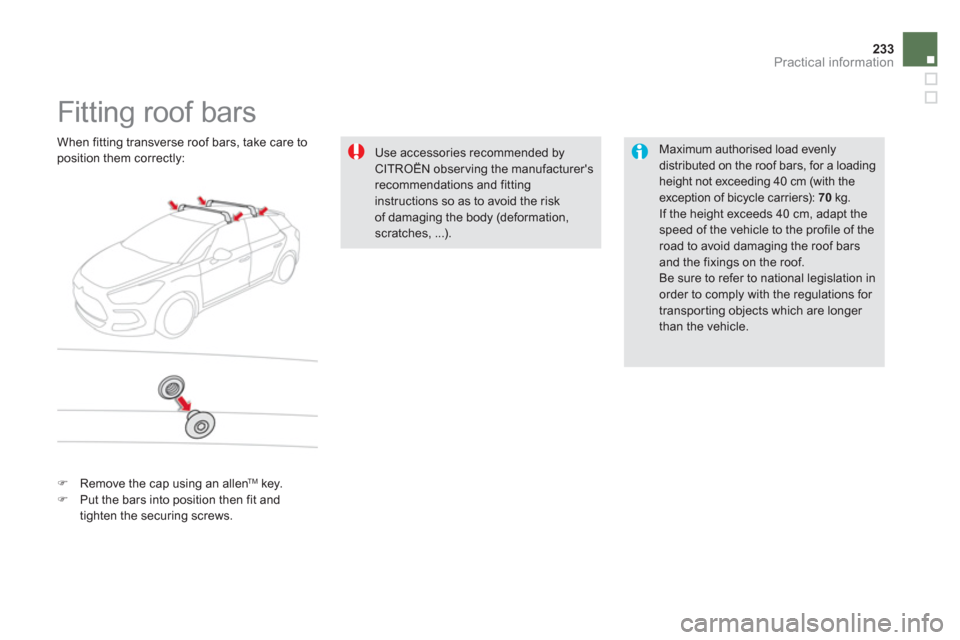
233Practical information
Fitting roof bars
Maximum authorised load evenly
distributed on the roof bars, for a loading height not exceeding 40 cm (with theexception of bicycle carriers): 70
kg.
If the height exceeds 40 cm, adapt the
speed of the vehicle to the profile of the road to avoid damaging the roof barsand the fixings on the roof.
Be sure to refer to national legislation in order to comply with the regulations for transporting objects which are longer than the vehicle.
When
fitting transverse roof bars, take care to position them correctly: Use accessories recommended by CITROËN obser ving the manufacturer'srecommendations and fitting instructions so as to avoid the risk of damaging the body (deformation, scratches, ...).
�)Remove the cap using an allen TM
key. �)Put the bars into position then fit and
tighten the securing screws.